Passive Radio-Frequency Identification Tag-Based Indoor Localization in Multi-Stacking Racks for Warehousing
Abstract
:1. Introduction
2. Research Background
2.1. Introduction to RFID
2.2. RFID-Based Indoor Location Identification Methods
3. Inventory Location Identification Framework in MSR
3.1. Configuration of Tag Information
3.2. Indentification of Inventory Location
| Algorithm 1. Inventory location identification |
| Index: i: Index of column (i = 1 ,.., I) j: Index of row (j = 1, …, J) N: Number of the item loaded in each zone of the MSR c: Index of the radio-wave generation of the RFID reader in the j-th row (c = 1 ,…, C) Parameters: = A set of recognized tags when the RFID reader generates the c-th radio wave (i.e., the RFID reader performs the c-th scanning) in the j-th row of the rack = A set of recognized tags in which only one reference tag exists among . (Note that only the first recognized has to be selected if there are several ) = [Decision value] A set of identified item locations in Method: Step 1: Set T according to the distance between two adjacent reference tags attached to the MSR. Step 2: Calculate according to Equation (2) and set the measurement distance of the RFID reader within . Step 3: Set the tag recognition interval of the RFID reader, recognizing speed, and Step 4: Set i = 1 and j = 1, scan the tag information of the stock, and distinguish among . Step 5: Set = . Step 6: Exclude the reference tags and from : = − − reference tags. While c = C do{ c = c + 1 Exclude from : − If the number of stocks in = N, then let i = i + 1 and go to Step 5 }. Step 7: If i = I, then let j = j + 1, i = 1, c = 1, and go to Step 5. Stopping rule: If i = I and j = J, then the algorithm terminates. |
4. Experiment and Discussion
4.1. Results for the Accuracy of the Measurement Distance and Inventory Location Recognition
4.2. Results for Item Location Identification
5. Concluding Remarks
Author Contributions
Funding
Conflicts of Interest
References
- Jakob, M.; Grobmann, M.; Honle, N.; Nicklas, D. DCbot: Exploring the Web as Value-Added Service for Location-Based Applications. In Proceedings of the 21st International Conference on Data Engineering, Tokyo, Japan, 5–8 April 2005. [Google Scholar]
- Song, J.; Haas, C.; Caldas, C.; Ergen, E.; Akinci, B. Automating the task of tracking the delivery and receipt of fabricated pipe spools in industrial projects. Autom. Constr. 2006, 15, 166–177. [Google Scholar] [CrossRef]
- Aittola, M.; Ryhänen, T.; Ojala, T. Smart Library: Location-aware mobile library service. In Proceedings of the Fifth International Symposium on Human Computer Interaction with Mobile Devices and Services, Udine, Italy, 8–11 September 2003; pp. 411–416. [Google Scholar]
- Ting, Z.; Zhang, X.; Yuanxin, O. A Framework of Networked RFID System Supporting Location Tracking. In Proceedings of the 2006 2nd IEEE/IFIP International Conference in Central Asia on Internet, Tashkent, Uzbekistan, 19–21 September 2006; pp. 1–4. [Google Scholar]
- Kimoto, R.; Yamamoto, T.; Ishida, S.; Tagashira, S.; Fukuda, A. Evaluation of MultiZigLoc: Indoor ZigBee Localization System Using Inter-Channel Characteristics. In Proceedings of the 2018 Eleventh International Conference on Mobile Computing and Ubiquitous Network (ICMU), Auckland, NZ, USA, 5–8 October 2018; pp. 1–6. [Google Scholar]
- Seetharam, D.; Fletcher, R. Battery-Powered RFID. In Proceedings of the Sense ID 2007 1st ACM Workshop on Convergence of RFID and Wireless Sensor Networks and their Applications, Sydney, Australia, 4–9 November 2007; pp. 1–6. [Google Scholar]
- Takahashi, H.; Yanagita, T.E.; Suzuki, T.; Maeda, A.; Nakai, N.; Maeda, Y.; Shinga, K.; Hirokawa, T.; Ogawa, R.; Hara, M.; et al. Accurate localization of rectal cancer using near infrared ray-guided surgery with intra-operative colonoscopy and da Vinci Firefly technology. Surg. Today 2020, 50, 205–208. [Google Scholar] [CrossRef] [PubMed]
- Dai, D.; He, Q. Structure damage localization with ultrasonic guided waves based on a time–frequency method. Signal Process. 2014, 96, 21–28. [Google Scholar] [CrossRef]
- Finkenzeller, K. RFID Handbook: Fundamentals and Applications in Contactless Smart Cards, Radio Frequency Identification and Near-Field Communication, 3rd ed.; John Wiley & Sons: Wiltshire, UK, 2010. [Google Scholar]
- Li, N.; Becerik-Gerber, B. Performance-Based evaluation of RFID-Based indoor location sensing solutions for the built environment. Adv. Eng. Inform. 2011, 25, 535–546. [Google Scholar] [CrossRef]
- Dziadak, K.; Kumar, B.; Sommerville, J. Model for the 3D location of buried assets based on RFID technology. J. Comput. Civ. Eng. 2009, 23, 148–159. [Google Scholar] [CrossRef]
- Alarifi, A.; Al-Salman, A.; Alsaleh, M.; Alnafessah, A.; Al-Hadhrami, S.; Al-Ammar, M.A.; Al-Khalifa, H.S. Ultra wideband indoor positioning technologies: Analysis and recent advances. Sensors 2016, 16, 707. [Google Scholar] [CrossRef]
- Ni, L.M.; Liu, Y.; Lau, Y.C.; Patil, A.P. LANDMARC: Indoor location sensing using active RFID. In Proceedings of the First IEEE International Conference on Pervasive Computing and Communications 2003, Fort Worth, TX, USA, 23–26 March 2003; pp. 407–415. [Google Scholar]
- Goodrum, P.; McLaren, M.; Durfee, A. The application of active radio frequency identification technology for tool tracking on construction job sites. Autom. Constr. 2006, 15, 291–302. [Google Scholar] [CrossRef]
- Ergen, E.; Akinci, B.; East, B.; Kirby, J. Tracking components and maintenance history within a facility utilizing radio frequency identification technology. J. Comput. Civ. Eng. 2007, 21, 11–20. [Google Scholar] [CrossRef]
- OECD. Net employment creation and destruction between 2010 and 2016. In OECD SME and Entrepreneurship Outlook 2019; OECD Publishing: Paris, France, 2019. [Google Scholar]
- Tesoriero, R.; Tebar, R.; Gallud, J.A.; Lozano, M.D.; Penichet, V.M.R. Improving location awareness in indoor spaces using RFID technology. Expert Syst. Appl. 2010, 37, 894–898. [Google Scholar] [CrossRef]
- Montaser, A.; Moselhi, O. RFID indoor location identification for construction projects. Autom. Constr. 2014, 39, 167–179. [Google Scholar] [CrossRef]
- Jaselskis, E.; El-Misalami, T. Implementing radio frequency identification in the construction process. J. Constr. Eng. Manag. 2003, 129, 680–688. [Google Scholar] [CrossRef]
- Chae, S.; Yoshida, T. Application of RFID Technology to prevention of collision accident with heavy equipment. Autom. Constr. 2010, 19, 368–374. [Google Scholar] [CrossRef]
- Legner, C.; Thiesse, F. RFID-Based maintenance at Frankfurt airport. IEEE Pervasive Comput. 2006, 5, 34–39. [Google Scholar] [CrossRef]
- Hightower, J.; Borriello, G. Location systems for ubiquitous computing. Computer 2001, 34, 57–66. [Google Scholar] [CrossRef] [Green Version]
- Al Nuaimi, K.; Kamel, H. A survey of indoor positioning systems and algorithms. In Proceedings of the 2011 IEEE International Conference on Innovations in Information Technology, Abu Dhabi, UAE, 25–27 April 2011. [Google Scholar]
- BSR INCITS 371.2. Real Time Locating System (RTLS)—Part 2: 433MHz Air Interface Protocol; American National Standards Institute (ANSI): New York, NY, USA, 2003. [Google Scholar]
- Huang, C.-L.; Chung, P.-C.; Tsai, M.-H.; Yang, Y.-K.; Hsu, Y.-C. Reliability Improvement for an RFID-based Psychiatric Patient Localization System. Int. J. Comput. Commun. 2008, 31, 2039–2048. [Google Scholar] [CrossRef]
- D’Mello, S.; Mathews, E.; McCauley, L.; Markham, J. Impact of position and orientation of RFID tags on real time asset tracking in a supply chain. J. Theor. Appl. Electron. Commer. Res. 2008, 3, 1–12. [Google Scholar]
- Lim, M.K.; Bahr, W.; Leung, S.C.H. RFID in the warehouse: A literature analysis (1995–2010) of its applications, benefits, challenges and future trends. Int. J. Prod. Econ. 2013, 145, 409–430. [Google Scholar] [CrossRef] [Green Version]
- Alyahya, S.; Wang, Q.; Bennett, N. Application and integration of an RFID-enabled warehousing management system—A feasibility study. J. Ind. Inf. Integr. 2016, 4, 15–25. [Google Scholar] [CrossRef] [Green Version]
- Zhou, W.; Piramuthu, S.; Chuc, F.; Chue, C. RFID-enabled flexible warehousing. Decis. Support Syst. 2017, 98, 99–112. [Google Scholar] [CrossRef]
- Choy, K.L.; Ho, G.T.S.; Lee, C.K.H. A RFID-based storage assignment system for enhancing the efficiency of order picking. J. Intell. Manuf. 2017, 28, 111–129. [Google Scholar] [CrossRef]
- Hightower, J.; Want, R.; Borriello, G. SpotON: An Indoor 3d Location Sensing Technology Based on Rf Signal Strength; Technical Report UW CSE #2000-02-02; University of Washington: Seattle, WA, USA, 2000. [Google Scholar]
- Sue, K.-L.; Tsai, C.-H.; Lin, M.-H. FLEXOR: A Flexible Localization Scheme Based on RFID. In Proceedings of the Information Networking. Advances in Data Communications and Wireless Networks, Sendai, Japan, 16–19 January 2006. [Google Scholar]
- Jin, G.-Y.; Lu, X.-Y.; Park, M.-S. An Indoor Localization Mechanism Using Active RFID Tag. In Proceedings of the IEEE International Conference on Sensor Networks, Ubiquitous, and Trustworthy Computing, Taichung, Taiwan, 5–7 June 2006; pp. 40–43. [Google Scholar]
- Hahnel, D.; Burgard, W.; Fox, D.; Fishkin, K.; Philipose, M. Mapping and localization with RFID technology. In Proceedings of the IEEE International Conference on Robotics and Automation, New Orleans, LA, USA, 26 April–1 May 2004. [Google Scholar]
- Chattopadhyay, A.; Harish, A.R. Analysis of low range Indoor Location Tracking techniques using Passive UHF RFID tags. In Proceedings of the 2008 IEEE Radio and Wireless Symposium, Orlando, FL, USA, 22–24 January 2008. [Google Scholar]
- Liu, X.; Corner, M.; Shenoy, P. Ferret: RFID localization for pervasive multimedia. In Proceedings of the 8th International Conference (UbiComp 2006), Orange County, CA, USA, 17–21 September 2006. [Google Scholar]
- Nemmaluri, A.; Corner, M.D.; Shenoy, P. Sherlock: Automatically Locating Objects for Humans. In Proceedings of the 6th International Conference on Mobile Systems, Application, and Service, Breckenridge, CO, USA, 17–20 June 2008. [Google Scholar]
- DiGiampaolo, E.; Martinelli, F. A robotic system for localization of passive UHF-RFID tagged objects on shelves. IEEE Sens. J. 2018, 18, 8558–8568. [Google Scholar] [CrossRef]
- González, J.F.A.; Smith, N.R.; Vargas-Rosales, C. A method for identifying multiple RFID tags in high electromagnetic interference environments. Can. J. Electr. Comput. Eng. 2015, 38, 346–352. [Google Scholar] [CrossRef]
- Liu, C.-G.; Liu, I.-H.; Lin, C.-D.; Li, J.-S. A novel tag searching protocol with time efficiency and searching accuracy in RFID systems. Comput. Netw. 2019, 150, 201–216. [Google Scholar] [CrossRef]
- R-Squared. Available online: https://www.investopedia.com/terms/r/r-squared.asp (accessed on 23 May 2020).
- Wasserstein, R.L.; Lazar, N.A. The ASA’s Statement on p-Values: Context, Process, and Purpose. Am. Stat. 2016, 70, 129–133. [Google Scholar] [CrossRef] [Green Version]
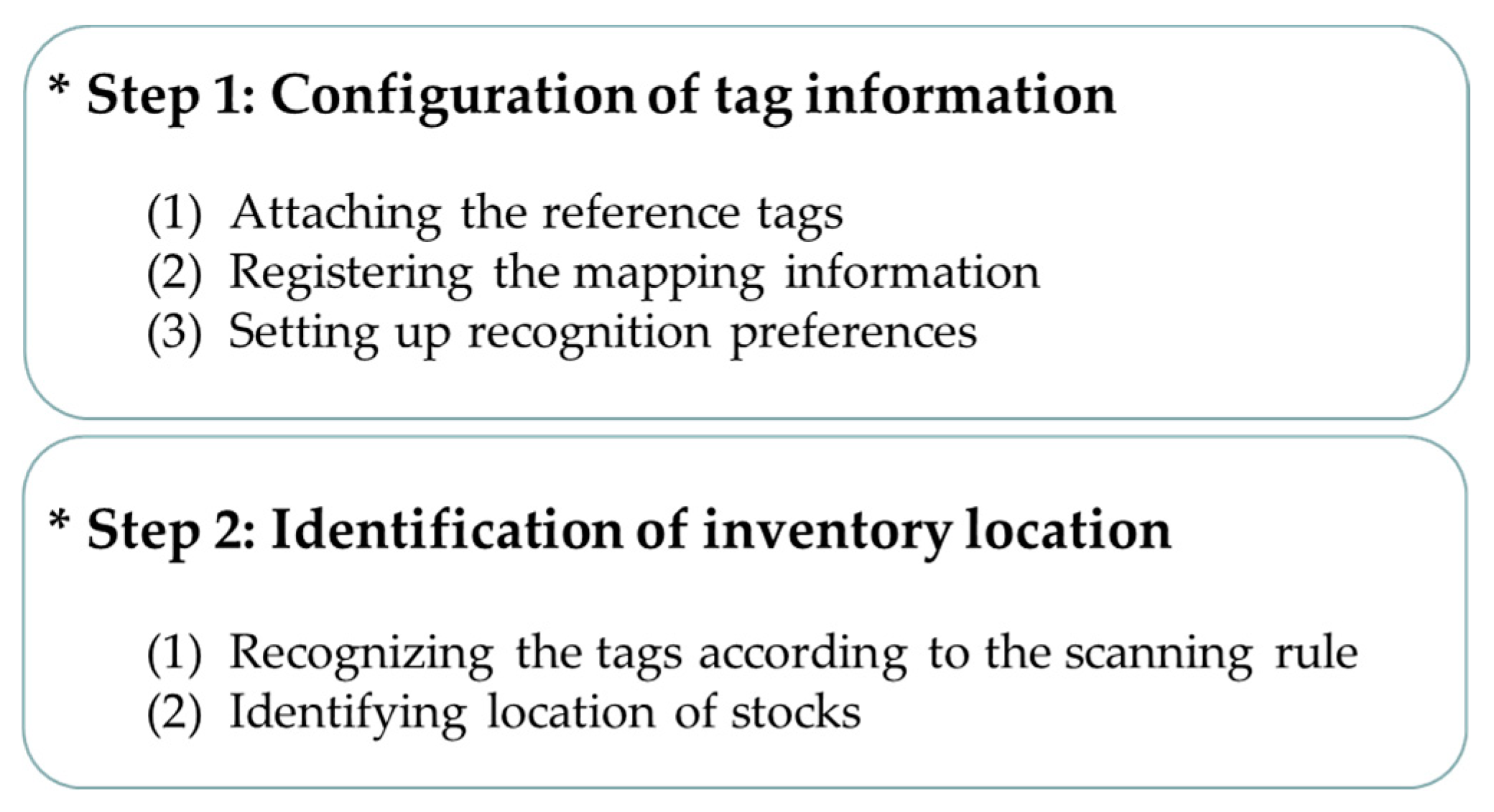
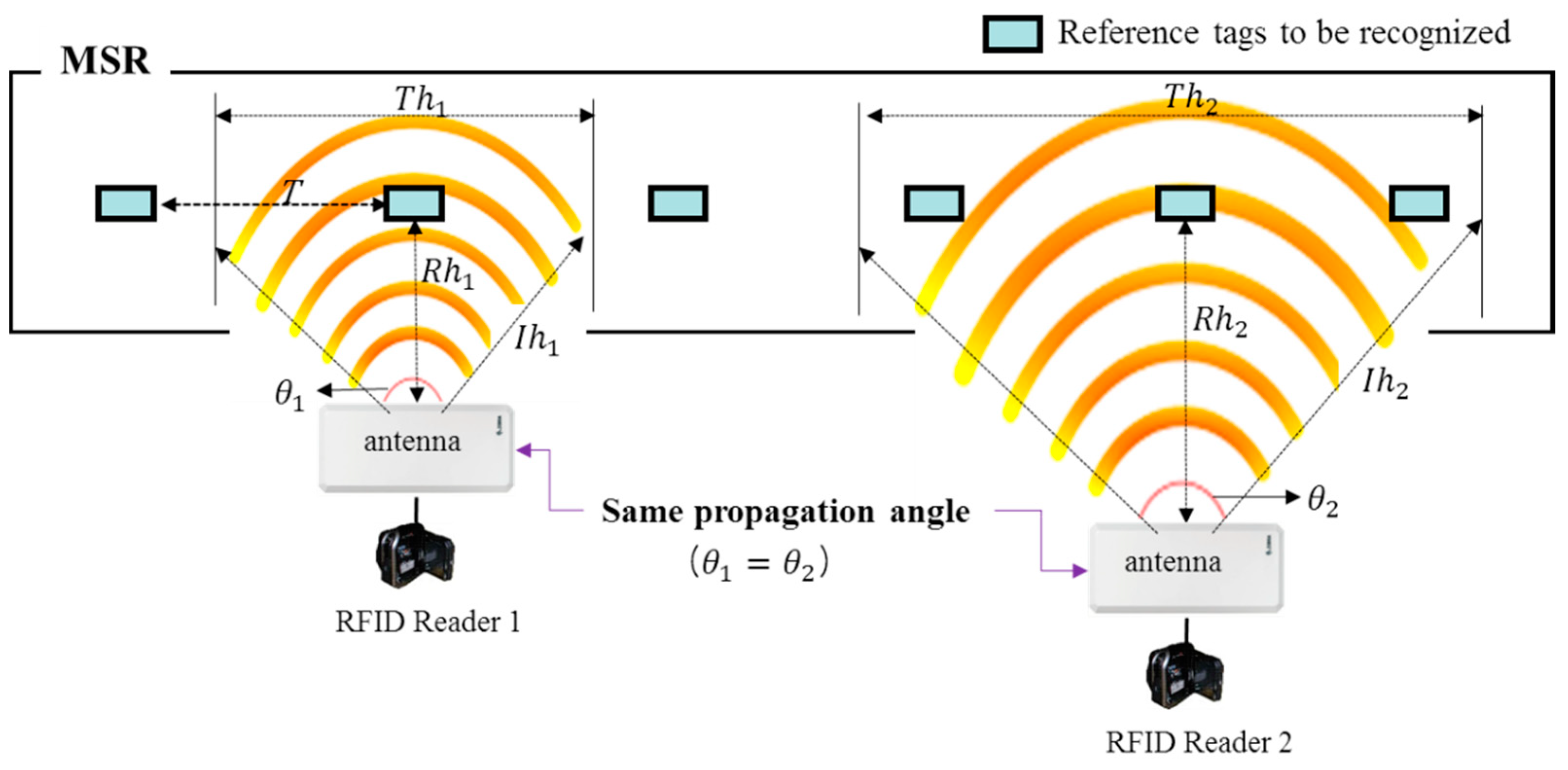
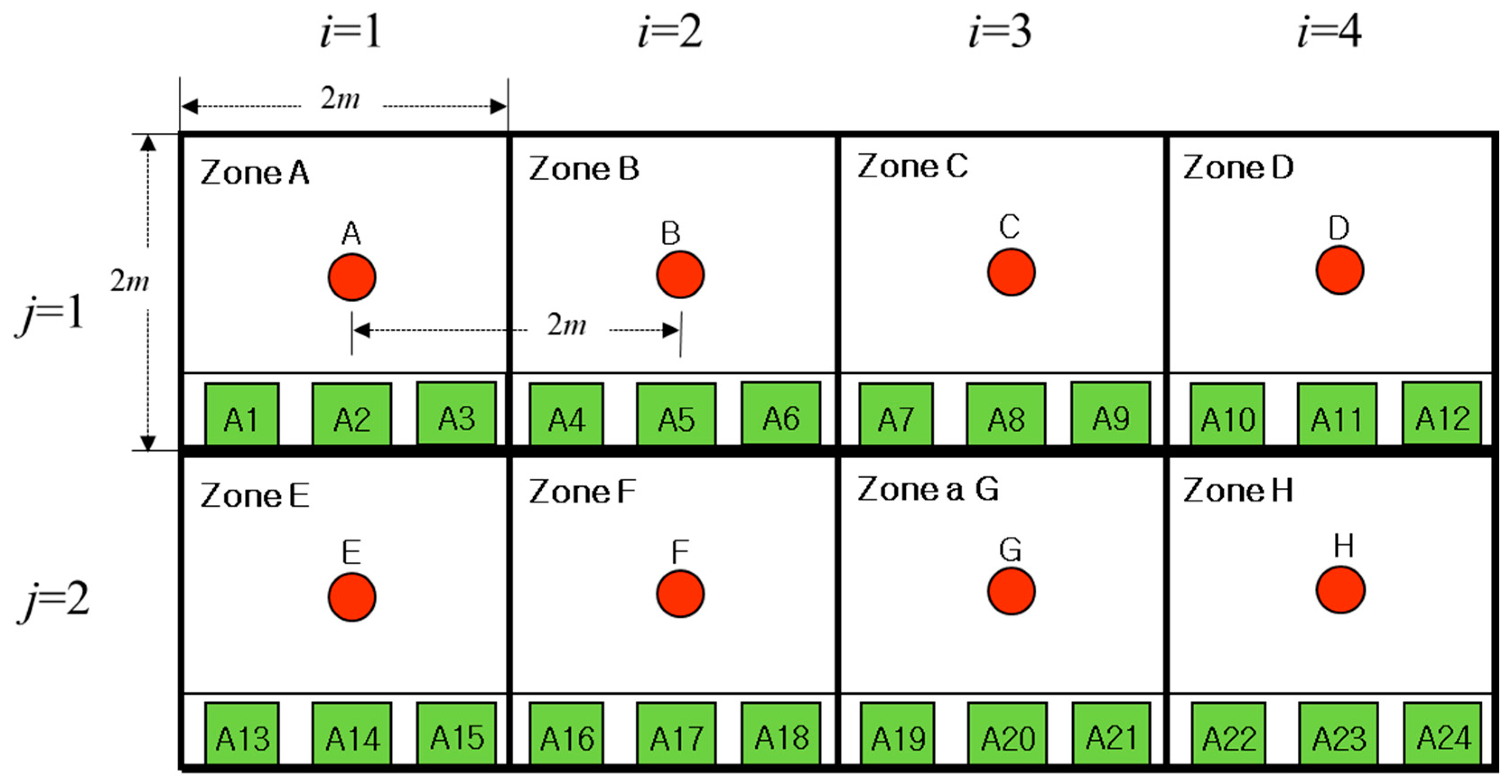

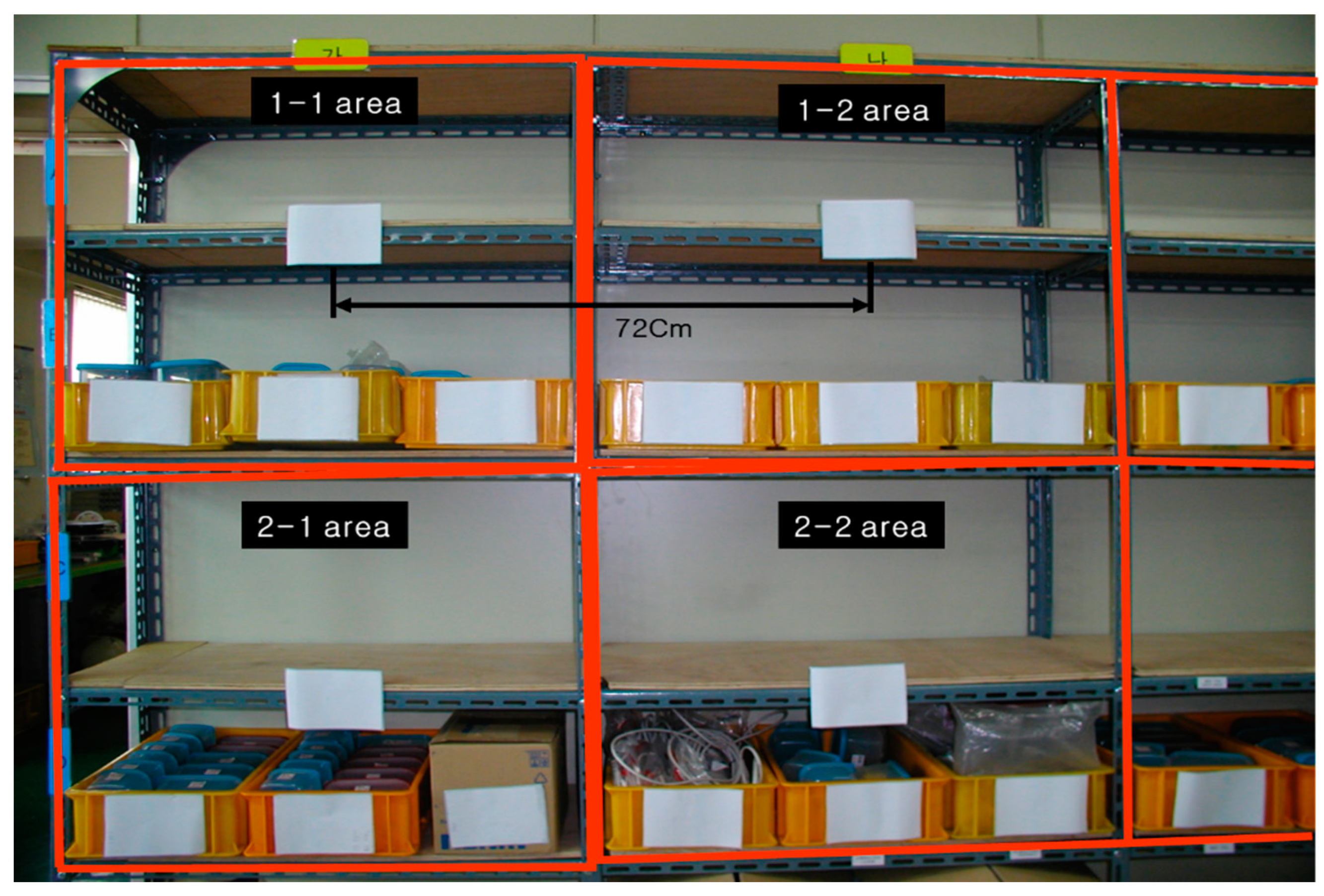
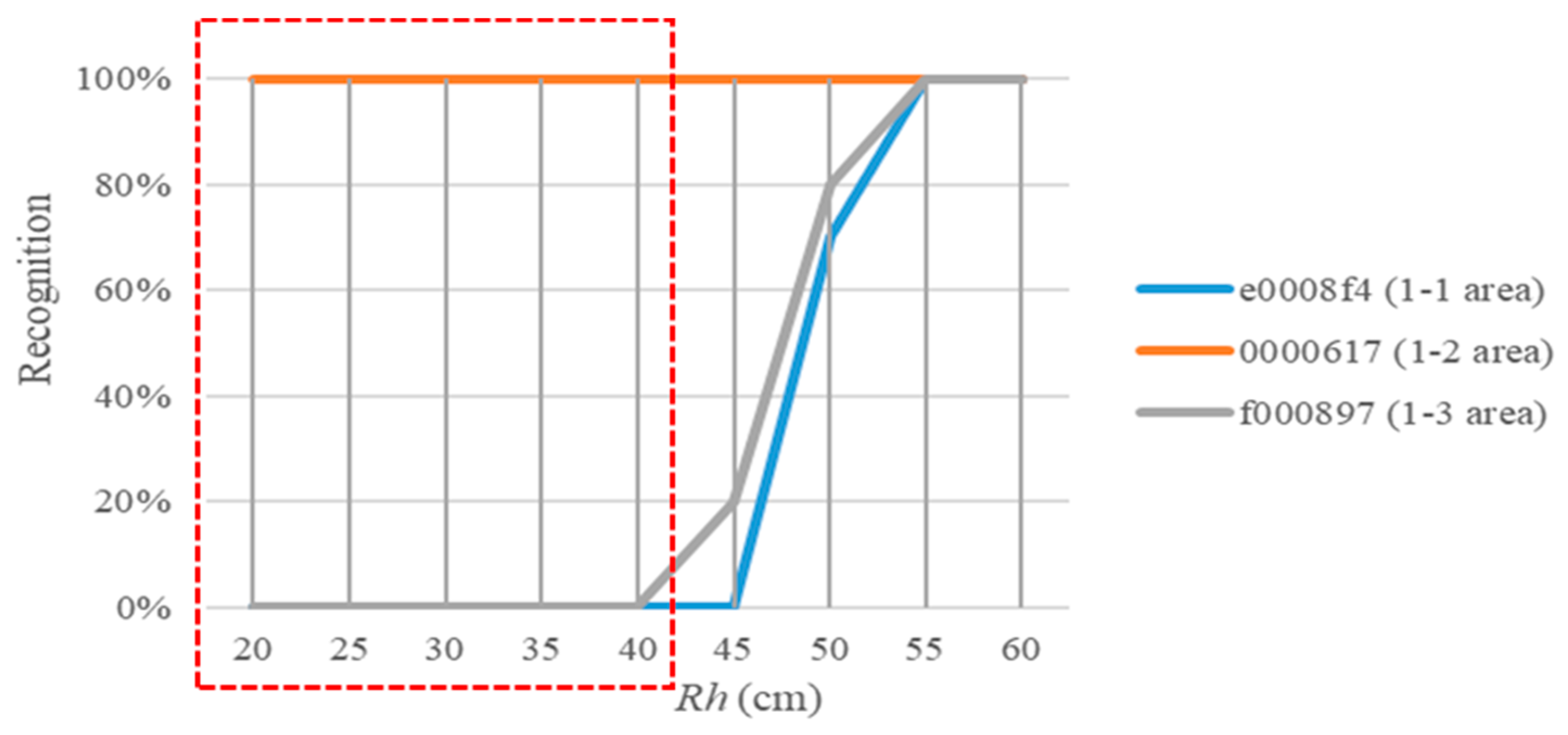


| Recognized Tag Information of Stocks | Number of Reference Tags | ||
|---|---|---|---|
| A, A1, A2, A3, A4 | 1 | ||
| A, A1, A2, A3, A4, A5, B | 2 | ||
| A, A2, A3, A4, A5, A6, B | 2 | ||
| B, A3, A4, A5, A6, A7 | 1 | ||
| B, C, A4, A5, A6, A7, A8 | 2 | ||
| B, C, A5, A6, A7, A8, A9 | 2 | ||
| C, A6, A7, A8, A9, A10 | 1 | ||
| C, A7, A8, A9, A10, A11, D | 2 | ||
| C, A8, A9, A10, A11, A12, D | 2 | ||
| D, A9, A10, A11, A12 | 1 | ||
| D, A10, A11, A12 | 1 | ||
| D, A11, A12 | 1 | ||
| - | 0 |
| Number of Stocked Items | Tag Recognition Intervals of the RFID Reader (sec) | ||||||||
|---|---|---|---|---|---|---|---|---|---|
| 0.3 | 0.5 | 1 | 2 | 3 | 4 | 5 | Mean | Standard Deviation | |
| 1 | 100 | 100 | 100 | 85 | 70 | 50 | 50 | 79 | 22.8 |
| 2 | 100 | 100 | 100 | 80 | 60 | 30 | 30 | 71 | 31.8 |
| 3 | 100 | 95 | 95 | 75 | 55 | 25 | 20 | 66 | 33.8 |
| 4 | 95 | 90 | 90 | 70 | 50 | 15 | 10 | 60 | 35.9 |
| 5 | 90 | 80 | 80 | 60 | 35 | 10 | 0 | 51 | 36.1 |
| 6 | 90 | 80 | 80 | 55 | 30 | 5 | 0 | 49 | 37.3 |
| 7 | 90 | 80 | 80 | 45 | 15 | 0 | 0 | 44 | 39.6 |
| Mean | 95 | 89 | 89 | 67 | 45 | 19 | 16 | ||
| Standard deviation | 5.0 | 9.3 | 9.3 | 14.4 | 19.1 | 17.2 | 19.0 | ||
© 2020 by the authors. Licensee MDPI, Basel, Switzerland. This article is an open access article distributed under the terms and conditions of the Creative Commons Attribution (CC BY) license (http://creativecommons.org/licenses/by/4.0/).
Share and Cite
Park, J.; Kim, Y.-J.; Lee, B.K. Passive Radio-Frequency Identification Tag-Based Indoor Localization in Multi-Stacking Racks for Warehousing. Appl. Sci. 2020, 10, 3623. https://doi.org/10.3390/app10103623
Park J, Kim Y-J, Lee BK. Passive Radio-Frequency Identification Tag-Based Indoor Localization in Multi-Stacking Racks for Warehousing. Applied Sciences. 2020; 10(10):3623. https://doi.org/10.3390/app10103623
Chicago/Turabian StylePark, Jaehun, Yong-Jeong Kim, and Byung Kwon Lee. 2020. "Passive Radio-Frequency Identification Tag-Based Indoor Localization in Multi-Stacking Racks for Warehousing" Applied Sciences 10, no. 10: 3623. https://doi.org/10.3390/app10103623






